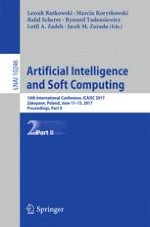2017 | Buch
Artificial Intelligence and Soft Computing
16th International Conference, ICAISC 2017, Zakopane, Poland, June 11-15, 2017, Proceedings, Part II
herausgegeben von: Leszek Rutkowski, Marcin Korytkowski, Rafał Scherer, Ryszard Tadeusiewicz, Lotfi A. Zadeh, Jacek M. Zurada
Verlag: Springer International Publishing
Buchreihe : Lecture Notes in Computer Science
